Climbing Gym Financial Model
5 Year 3 Statement Indoor Rock Climbing Gym Financial Model in MS Excel provides a structured framework to analyze financial health and projections of your Rock Climbing Gym’s profitability.
Financial Model for an Indoor Rock Climbing Gym
A financial model for an indoor rock climbing gym provides projections for revenue, expenses, and profitability, and includes essential components of the Income Statement, Cash Flow Statement, and Balance Sheet.
5 Year, 3 Statement with Revenue from 6 Tier Subscription and PAYG Services,
Income Statement (Profit & Loss Statement)
The income statement outlines revenue, cost of goods sold (COGS), operating expenses, and net profit.
Revenue Streams
- Membership Fees – Recurring revenue from monthly or annual memberships.
- Day Passes – One-time entry fees for non-members.
- Climbing Classes & Coaching – Revenue from beginners’ classes, advanced training, and personal coaching.
- Equipment Rentals – Shoes, harnesses, chalk bags, and other climbing gear rentals.
- Retail Sales – Merchandise sales, including climbing gear, clothing, and accessories.
- Café & Concessions – Revenue from food, drinks, and snacks.
- Corporate Events & Parties – Revenue from team-building events and birthday parties.
- Sponsorships & Advertising – Income from local businesses sponsoring events or advertisements in the gym.
Cost of Goods Sold (COGS)
- Equipment rental costs (wear & tear, maintenance)
- Merchandise and retail inventory costs
- Instructor wages for classes (variable cost)
- Café inventory costs (if applicable)
Operating Expenses
- Salaries & Wages – Staff wages, instructor pay, administrative salaries
- Rent & Utilities – Lease payments, electricity, water, heating/cooling
- Insurance – Business liability, workers’ compensation, equipment insurance
- Marketing & Advertising – Social media ads, local promotions, referral programs
- Maintenance & Repairs – Equipment upkeep, wall setting, safety inspections
- Software & Subscriptions – CRM, booking software, payroll, accounting software
- Legal & Professional Fees – Lawyer and accountant fees
- Depreciation – Climbing holds, ropes, auto belays, and other assets
Net Profit Calculation
Gross Profit = Total Revenue – COGS
Operating Profit = Gross Profit – Operating Expenses
Net Profit (After Tax) = Operating Profit – Taxes
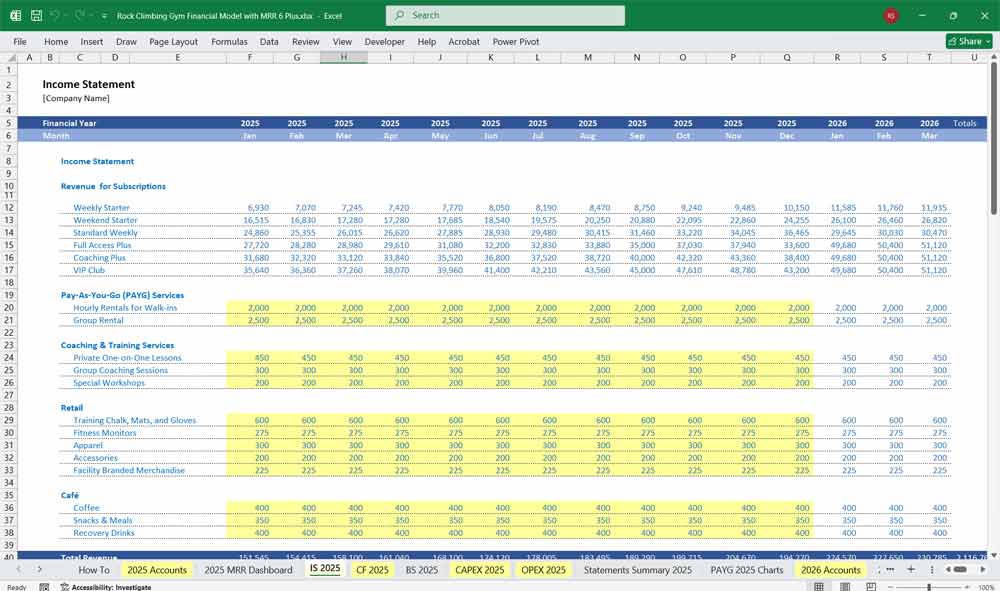
Climbing Gym Cash Flow Statement
The cash flow statement tracks the movement of cash in and out of the business.
Cash Flow from Operating Activities
Inflows:
- Membership payments
- Day pass sales
- Equipment rentals
- Merchandise sales
- Class fees
Outflows:
- Staff wages
- Rent & utilities
- Maintenance expenses
- Marketing costs
- Insurance payments
- Supplier payments (retail inventory, café inventory)
Cash Flow from Investing Activities
Capital Expenditures:
- Climbing walls construction
- Holds, ropes, auto-belays, crash pads
- Renovations or gym expansion
- Purchase of new rental equipment
Sale of Assets (if any):
- Selling used climbing gear
- Resale of old gym equipment
Cash Flow from Financing Activities
Cash Inflows:
- Business loans
- Investor contributions
- Crowdfunding or grants (if applicable)
Cash Outflows:
- Loan repayments
- Interest payments
- Dividend payouts (if applicable)
Net Cash Flow = Operating Cash Flow + Investing Cash Flow + Financing Cash Flow
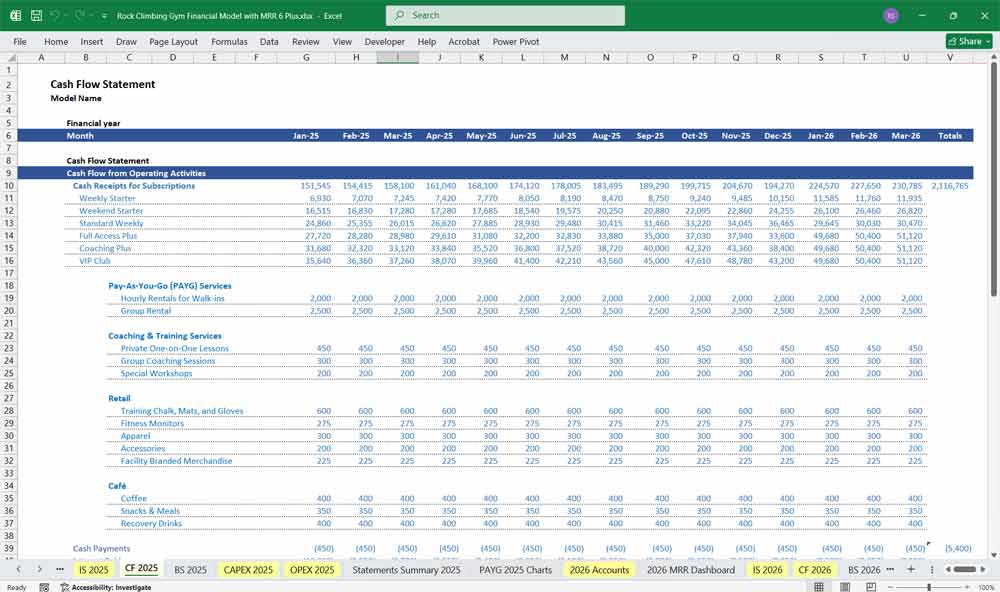
Climbing Gym Balance Sheet
The balance sheet provides a snapshot of the gym’s financial position at a specific point in time.
Assets
Current Assets
- Cash & Bank Balance – Available cash for operations
- Accounts Receivable – Unpaid membership dues or event payments
- Inventory – Merchandise stock, rental equipment, café stock
- Prepaid Expenses – Prepaid rent, insurance, and marketing expenses
Non-Current Assets
- Property, Plant & Equipment (PP&E) – Climbing walls, holds, harnesses, crash pads, gym flooring
- Intangible Assets – Brand goodwill, software licenses
- Accumulated Depreciation – Reduction in value of assets over time
Liabilities
Current Liabilities
- Accounts Payable – Payments due to suppliers
- Short-Term Loans – Repayments due within a year
- Salaries Payable – Staff wages owed but not yet paid
- Taxes Payable – Sales tax, payroll tax, income tax obligations
Long-Term Liabilities
- Long-Term Loans – Bank loans or investor funding with extended repayment terms
- Lease Obligations – Future rent commitments for gym space
Climbing Gym Equity
- Owner’s Equity / Retained Earnings – Initial investment and retained earnings
- Investor Contributions – Funds from business partners or venture capital
Balance Sheet Equation:
Assets = Liabilities + Equity

6-tier subscription model for a rock climbing gym
It contains revenue goals, and the value provided at each level. Below is a detailed breakdown of the tiers, including their features, pricing considerations, and target audience. Each tier is designed to cater to different types of climbers, from casual visitors to dedicated enthusiasts.
Tier 1: Day Rock Climbing Gym Pass (Casual Climber)
Target Audience: First-time visitors, tourists, or occasional climbers.
Features:
Access to the gym for one day.
Use of bouldering and top-rope climbing areas.
Basic safety orientation (if required).
Rental gear included (harness, shoes, chalk bag).
Limited access to fitness areas (if available).
Pricing: 20–20–30 per day.
Upsell Opportunities: Offer discounted multi-day passes or upgrades to higher tiers.
Tier 2: Punch Pass (Occasional Rock Climbing Gym)
Target Audience: Climbers who visit infrequently but want a discounted rate compared to day passes.
Features:
5 or 10 visits to the gym (expires after 6 months).
Access to all climbing areas (bouldering, top-rope, lead climbing).
Discounted gear rental (e.g., 50% off).
Access to fitness areas during visits.
Pricing: 80–80–150 for 5–10 visits.
Upsell Opportunities: Promote higher tiers for frequent climbers or offer add-ons like classes or personal training.
Tier 3: Basic Membership (Rock Climbing Gym Regular)
Target Audience: Climbers who visit 1–2 times per week.
Features:
Unlimited monthly access to the Rock Climbing gym.
Access to all climbing areas and fitness facilities.
Free gear rentals (shoes, harness, chalk bag).
Discounts on classes, workshops, and retail items (e.g., 10–15%).
Member-only events (e.g., social climbs, competitions).
Pricing: 60–60–90 per month.
Upsell Opportunities: Offer add-ons like personal training, advanced classes, or locker rentals.
Tier 4: Premium Rok Climbing Gym Membership (Dedicated Climber)
Target Audience: Climbers who visit 3+ times per week and want additional perks.
Features:
All Basic Gym Membership benefits.
Free guest passes (e.g., 1–2 per month).
Free access to advanced classes (e.g., lead climbing, technique workshops).
Priority booking for popular classes or events.
Locker rental included.
Discounts on personal training sessions.
Pricing: 100–100–130 per month.
Upsell Opportunities: Promote annual commitments for discounts or offer exclusive merchandise.
Tier 5: Family Rock Climbing Gym Membership (Group Climbers)
Target Audience: Families or groups of climbers who want to share a membership.
Features:
Covers 2–4 family members or friends.
Unlimited access for all members.
Free gear rentals for all members.
Discounts on classes and retail for all members.
Free guest passes (e.g., 2–4 per month).
Access to family-friendly events or workshops.
Pricing: 150–150–200 per month.
Upsell Opportunities: Offer add-ons like kids’ climbing programs or family-oriented events.
Tier 6: Elite Rock Climbing Gym Membership (Hardcore Enthusiast)
Target Audience: Serious climbers who want the ultimate experience and exclusive benefits.
Features:
All Premium Gym Membership benefits.
Unlimited guest passes.
Free access to all rock climbing classes, workshops, and training programs.
Complimentary personal training sessions (e.g., 1–2 per month).
Exclusive access to early rock climbing gym hours or private climbing sessions.
Free locker with premium amenities (e.g., towel service, toiletries).
VIP invitations to special events (e.g., climbing trips, pro climber meet-and-greets).
Pricing: 200–200–300 per month.
Upsell Opportunities: Offer annual memberships with additional perks or branded merchandise.
Additional Considerations for All Tiers:
Trial Periods: Offer a free or discounted trial for new members to experience the gym.
Annual Discounts: Provide a 10–15% discount for members who commit to an annual plan.
Referral Programs: Reward members who refer friends with free passes or discounts.
Community Building: Host member-only events, competitions, or social climbs to foster a sense of community.
Flexibility: Allow members to upgrade, downgrade, or pause their subscriptions as needed.
This 6-tier model ensures that climbers of all levels and budgets can find a subscription that suits their needs, while also maximizing revenue opportunities for the gym.
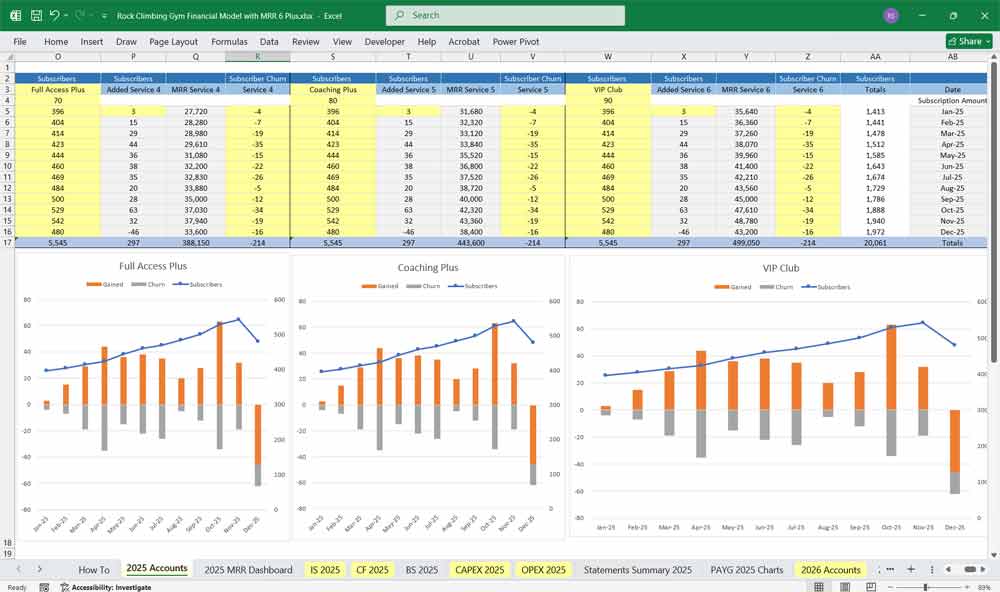
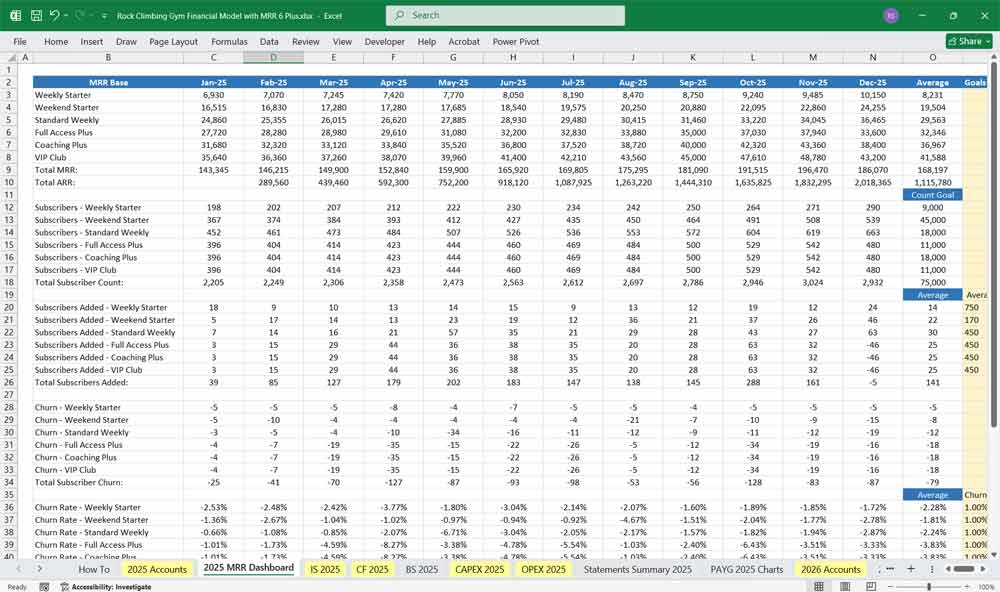
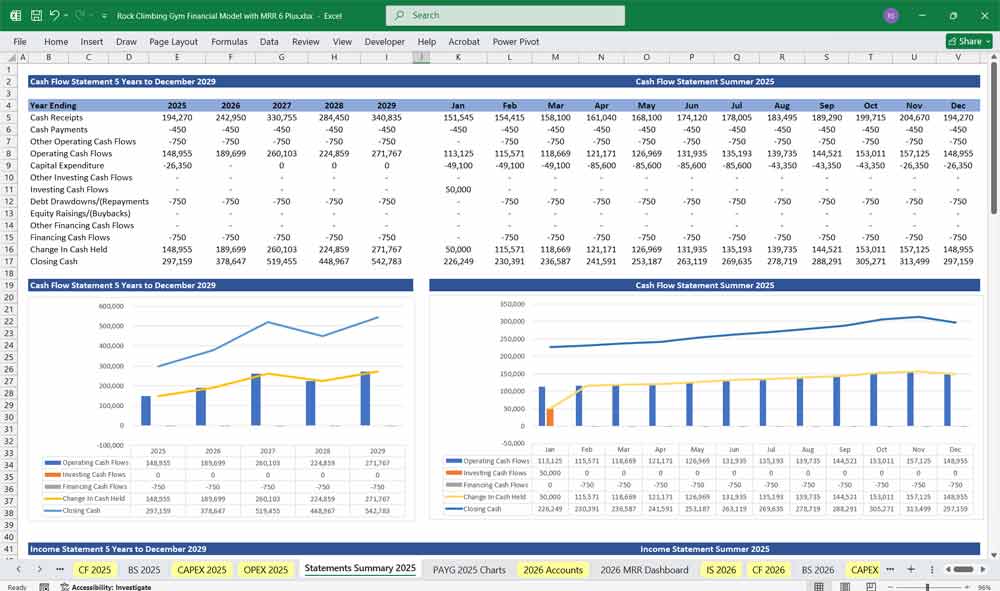
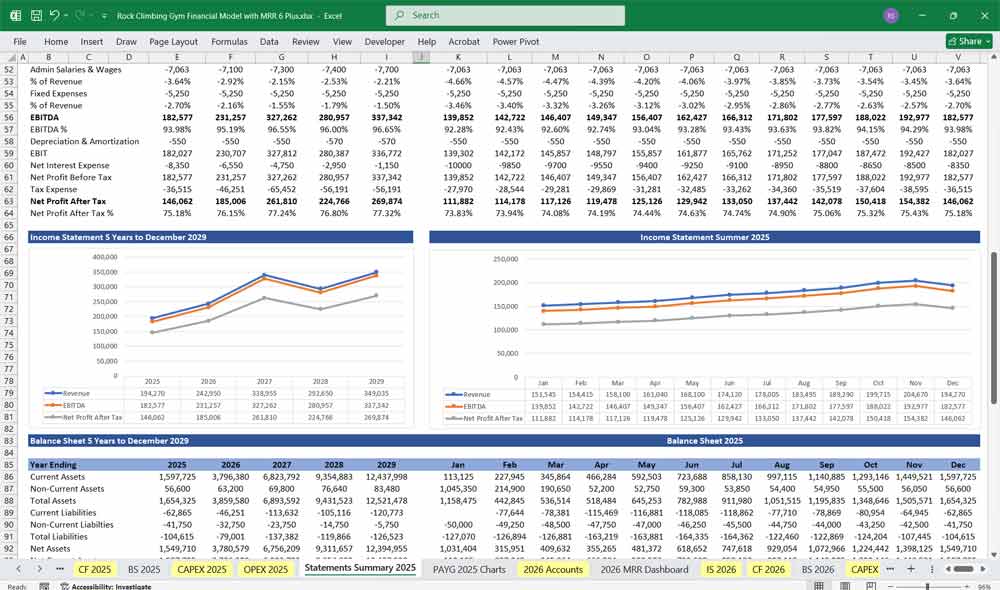
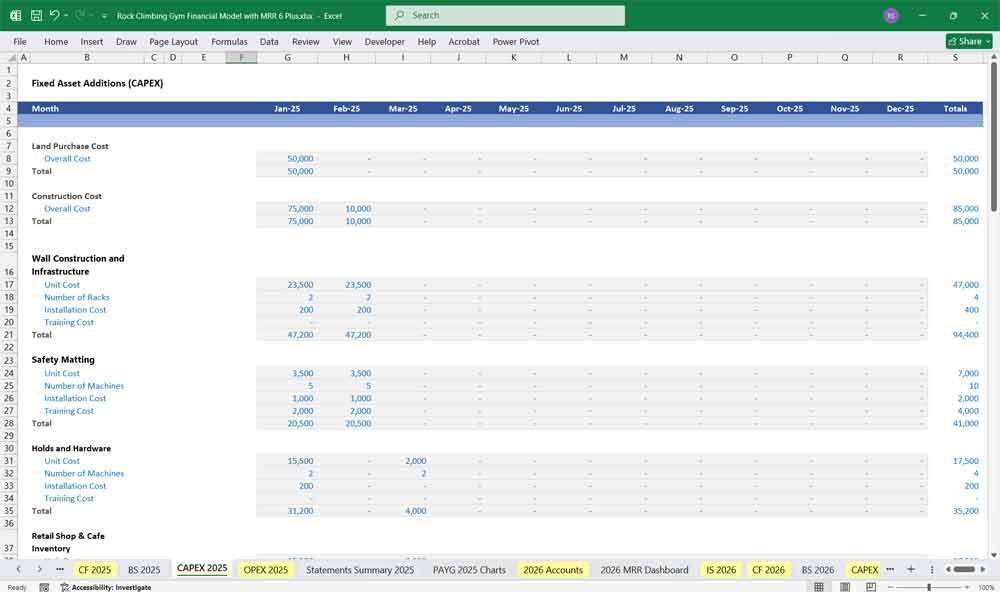
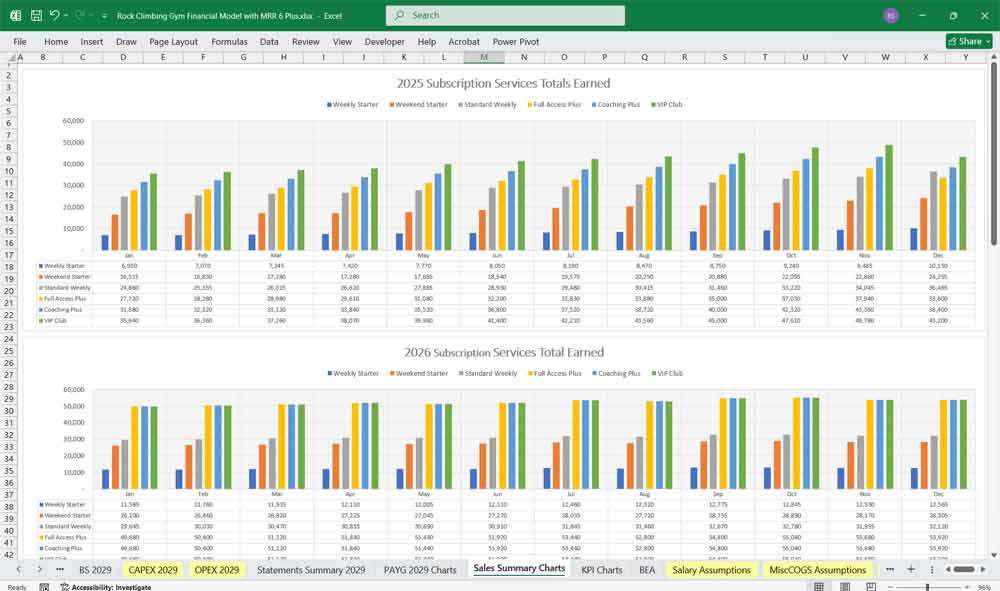
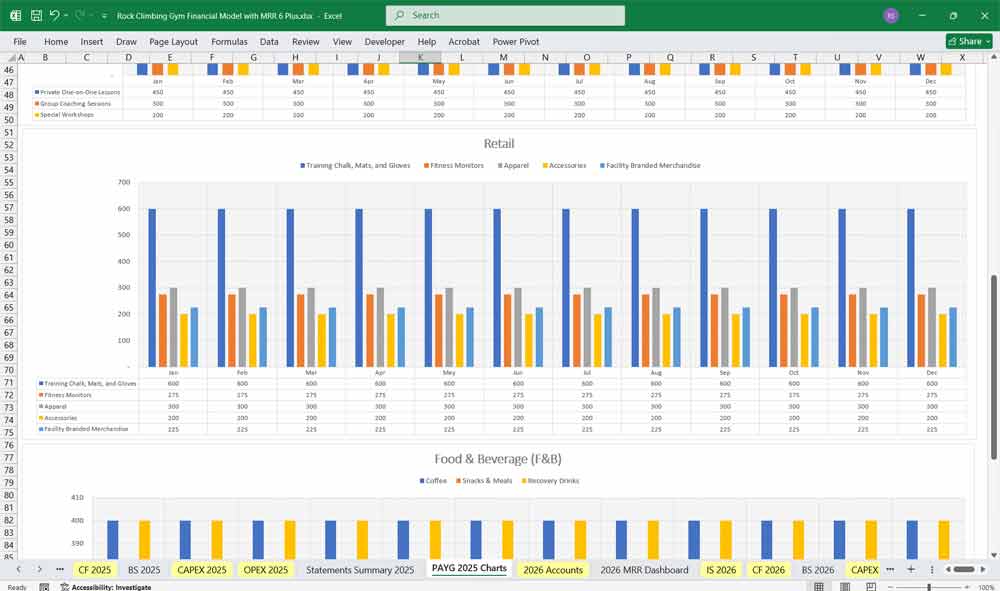
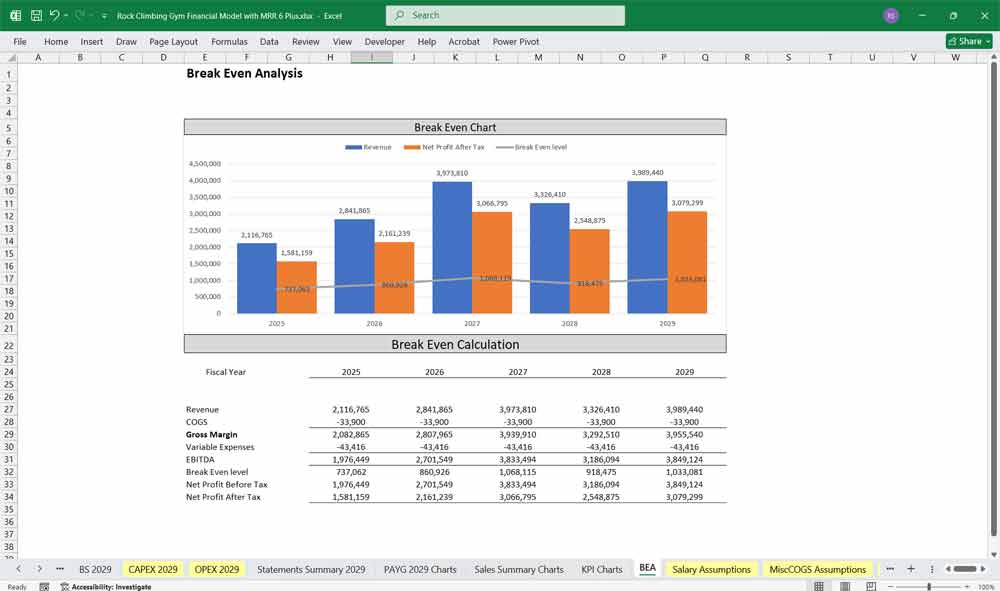
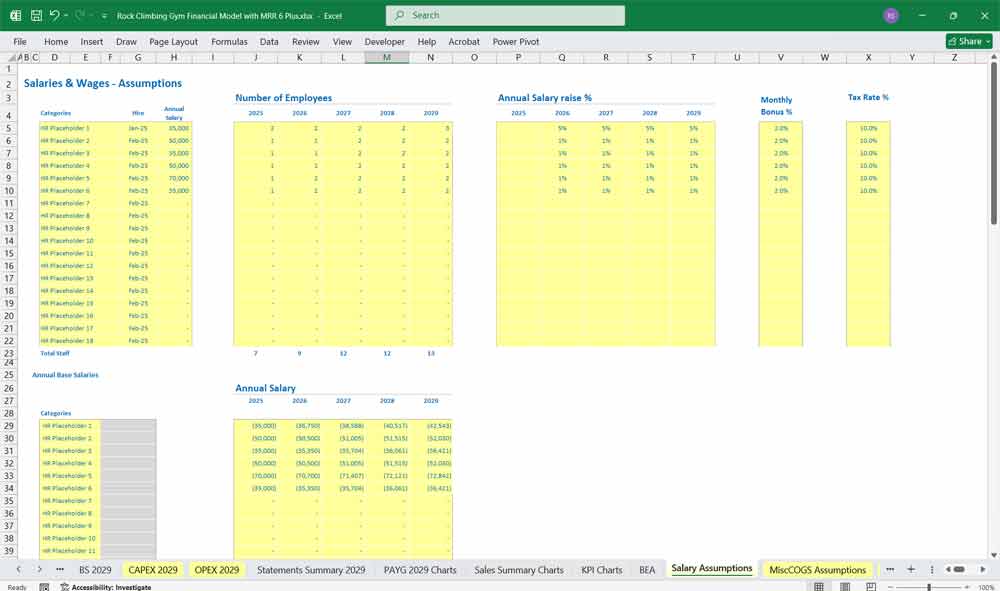

Ratios to Track In The Financial Model
- Gross Profit Margin = (Gross Profit / Total Revenue) × 100
- Net Profit Margin = (Net Profit / Total Revenue) × 100
- Current Ratio = Current Assets / Current Liabilities (Measures liquidity)
- Debt-to-Equity Ratio = Total Debt / Owner’s Equity (Measures leverage)
- Customer Acquisition Cost (CAC) = Marketing Costs / New Customers Acquired
- Lifetime Value of Customer (LTV) = Average Revenue Per Customer × Retention Period
Final Thoughts
A well-structured financial model for an indoor rock climbing gym helps in forecasting profitability, managing cash flow, and making informed business decisions. By monitoring revenues, expenses, and cash movements, gym owners can ensure sustainable growth and financial stability.
Download Link On Next Page
